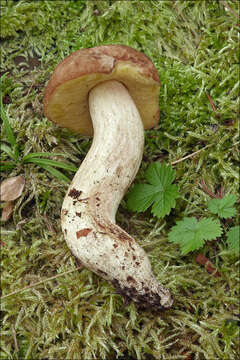Hemileccinum-depilatum_6

Description:
Hemileccinum depilatum (Redeuilh) utara, syn: Boletus depilatus Redeuilh, Leccinum depilatum (Redeuilh) utara, Xerocomus depilatus (Redeuilh) Manfr. Binder & Beslno name, DE: Gefleckthtigen Rhrling, Marmorierter Rhrling, Gehmmerter RhrlingSlo.: jamiasti gobanDat.: Sept.7.2016Lat.: 46.36171 Long.: 13.69624Code: Bot_1003/2016_DSC4778Habitat: light, young mixed wood and bushes, Ostrya carpinifolia dominant, some small, young Picea abies, a few very small (< 1 m tall) Fraxinus ornus, no Quercus and Carpinus in the vicinity; sparsely grass overgrown terrain in a mountain ravine; moderately inclined mountain slope, southeast aspect; base rich, colluvial, skeletal, calcareous ground, very shallow, soil layer on scree, sand and stones; half shade, relatively warm place; average precipitations ~ 3.000 mm/year, average temperature 5-7 deg C, elevation 745 m (2.440 feet), alpine phytogeographical region.Substratum: soil among stones.Place: Lower Trenta valley, between villages Soa and Trenta, right bank of river Soa, close to the place where the trail to abandoned settlement Na Skalah passes the ravine Sraunk, East Julian Alps, Posoje, Slovenia EC. Comments: This find was initially determined as Aureoboletus moravicus (Vacek) Klofac, syn: Boletus moravicus Vacek.. Because of some doubts in this determination the location has been revisited and new pilei collected (see Obs. no. 257921). Pilei cuticle shows a hymenophore appearance with erect hyphae composed of inflated cells as the most important distinguishing trait for Hemileccinum depilatum (Ref.:2). Also, almost certain mycorrhizal relation with Ostrya carpinifolia (Ref.: 3) (no other grown up trees in the vicinity), calcareous ground and other traits fit well to the descriptions of this fungus. Description: Two pilei growing together, almost confluent at the base; diameter 15 cm and 5.2 cm, tubes length 15 mm and 10 mm, context thick 23 mm and 12 mm respectively; stipe length 10 cm with 2.3 cm max diameter and 10.5 cm and 2.3 cm diameter respectively, tapering into a rooting base; smell almost absent or very mild, not unpleasant; taste mild, pleasant, a little bit mucous; tubes somewhat bruising darker when pressed on the older pileus; flesh when cut not bruising (also not on the young pileus, which contradicts to Ref.: 8); pilei surface and pore layer barely noticeably sticking when touched (in dry weather). SP light ocher-brown with slight green tint, oac839.Spores smooth, thick walled. Dimensions: 10.3 [11.9 ; 12.5] 14.1 x 4.6 [5.1 ; 5.3] 5.8 microns; Q = 2.1 [2.3 ; 2.4] 2.7; N = 36; C = 95%; Me = 12.2 x 5.2 microns; Qe = 2.4. Olympus CH20, NEA 100x/1.25, magnification 1.000 x, oil, fresh material, in water. AmScope MA500 digital camera. Herbarium: Mycotheca and lichen herbarium (LJU-Li) of Slovenian Forestry Institute, Vena pot 2, Ljubljana, Index Herbariorum LJFRef.:(1) Personal communication with Mr, Bojan Rot and Mr. Anton Poler.(2) P. Heinemann, J. Rammeloo, Two confused Boletes in the Benelux, Boletus impolitus Fries and Boletus depilatus Redeuilh, Persoonia (1992), Vol.14, pp 587-596; available at repository.naturalis.nl/document/569641 (3) Boris Assyov: boletales.com/genera/boletus/b-depilatus/ (4) G.J. Krieglsteiner (Hrsg.), Die Grosspilze Baden-Wrttembergs, Band 2, Ulmer (2000), p 228. (5) L. Hagar, Ottova Encyklopedia Hb, Ottova Nakladatelstvi, Praha (2015) (in Slovakian), p 525.(6) G. Kibby, British Boletes, Copyright Geoffrey Kibby (2011), p 17. (7) J. Breitenbach, F. Kraenzlin, Eds., Fungi of Switzerland, Vol.3. Verlag Mykologia (1991), p 52. 6(8) S. Buczacki, Collins Fungi Guide, Collins (2012), p 402. (9) tintling.com/pilzbuch/arten/b/Boletus_depilatus.html
Included On The Following Pages:
- Life (creatures)
- Cellular (cellular organisms)
- Eukaryota (eukaryotes)
- Opisthokonta (opisthokonts)
- Nucletmycea
- Fungi (mushrooms, lichens, molds, yeasts and relatives)
- Dikarya
- Basidiomycota (basidiomycete fungi)
- Agaricomycetes (Mushroom-Forming Fungi)
- Boletales
- Boletaceae (boletes)
- Hemileccinum
- Hemileccinum depilatum
This image is not featured in any collections.
Source Information
- license
- cc-by-nc-sa
- copyright
- Amadej Trnkoczy
- photographer
- Amadej Trnkoczy
- original
- original media file
- visit source
- partner site
- Flickr Group
- ID


